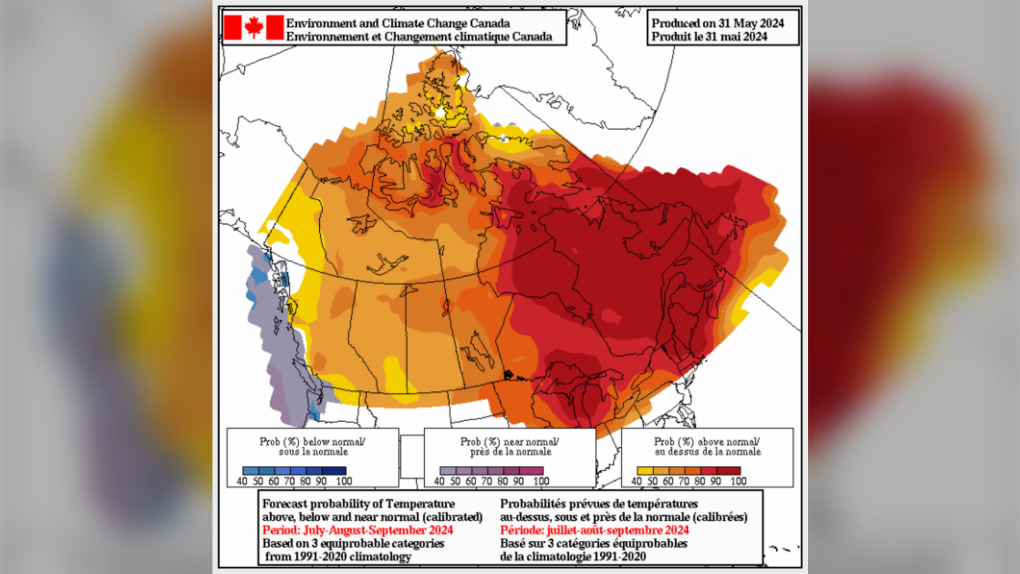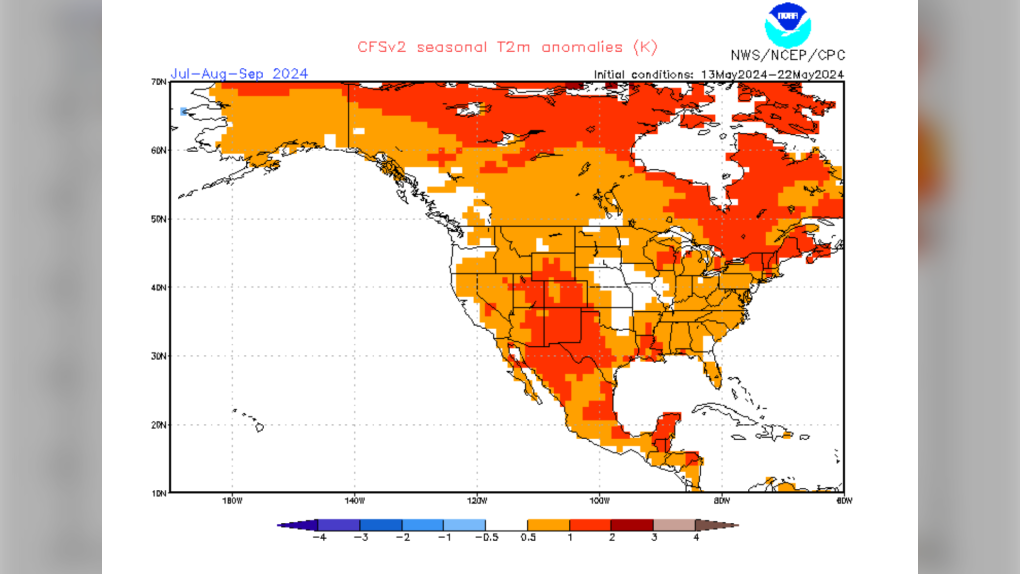Warm summer forecast for much of Canada, but how about the Maritimes?
Environment and Climate Change Canada expects a warmer than average summer for most of Canada.
The weather agency uses the Canadian Seasonal to Inter-annual Prediction System (CanSIPS) to help with longer range outlooks. CanSIPS is based on a collection of 10 forecasts from each of two physical climate computer models that take into account atmospheric, oceanic, and even land conditions.
For the period of July-to-September, the system ranges the Maritime with a 60-to-97 per cent chance of above normal temperatures. Likewise much of the surrounding ocean waters of the Maritimes are given a high probability of being above normal through that time.
No clear trend for precipitation in the Maritimes was indicated by the system. About equal probabilities of finishing July-August-September with either above, near, or below normal amounts of rain.
It is important to note these predictions are for general trends. There will be week-to-week and day-to-day fluctuations in weather conditions. Cooler days, hotter days, damp and dry stretches of weather are all still likely through the summer season.
 Above normal temperatures predicted by ECCC this summer. For the provincial capitals a 97 per cent chance of being above normal for Fredericton, 89 per cent for Halifax, and 97 per cent for Charlottetown. (Source: CanSIPS)
Above normal temperatures predicted by ECCC this summer. For the provincial capitals a 97 per cent chance of being above normal for Fredericton, 89 per cent for Halifax, and 97 per cent for Charlottetown. (Source: CanSIPS)
Second opinion
Other agencies around the world run seasonal prediction models as well. The National Oceanographic and Atmospheric Association (NOAA) of the United States runs seasonal climate forecast model called CFSv2.
Looking at the results from that model for the same period (July-August-September), it also predicts above normal temperatures. In contrast to CanSIPS, it indicates a higher chance of below normal amounts of precipitation, not only for the Maritimes but also the northeastern United States.
A second model run by the NOAA known as North American Multi-Model Ensemble (NMME) predicts above normal temperatures and near normal precipitation.
In summary there is good agreement between multiple systems that July-August-September will be above normal for temperatures in the Maritimes and less agreement as to whether precipitation will be above, near, or below normal.
 Seasonal guidance from the NOAA also predicts above normal temperatures through summer for the Maritimes. (Source: NOAA)
Seasonal guidance from the NOAA also predicts above normal temperatures through summer for the Maritimes. (Source: NOAA)
La Nina and the Atlantic hurricane season
The temperature of surface waters of the southern Pacific continue to transition from El Nino towards a neutral phase. The current forecast favours a transition from neutral to La Nina this summer.
Why does that matter? A La Nina phase in the Pacific favours a wind environment that is more favourable for tropical storm and hurricane development in the Atlantic. This was a primary factor in an active hurricane season forecast for this year.
While we are still waiting for our first named storm of the season, there are now areas being monitored for tropical system development in the southeastern Atlantic and the Gulf of Mexico.
Both regions are being given low chances over two and seven days. During the first part of the hurricane season, the Gulf of Mexico, Caribbean, and southeastern Atlantic are favoured for developing a tropical system. As the season progresses, development of a tropical system in the south-central Atlantic or near the coastline of Africa becomes more likely.
 Two areas, both being given a low chance of development, monitored as of Wednesday afternoon by the National Hurricane Center. (Source: CTV News Atlantic)
Two areas, both being given a low chance of development, monitored as of Wednesday afternoon by the National Hurricane Center. (Source: CTV News Atlantic)
CTVNews.ca Top Stories

Lawyers looking for thousands of families owed money by Veterans Affairs
The suit was launched after the Office of the Veterans Ombud found the government had been improperly calculating the disability benefits and pensions of its clients starting in 2003.
BREAKING House explodes in Transcona; Winnipeg firefighters responding
The City of Winnipeg is asking people to avoid the area of Camrose Bay after a house exploded.
'Why did I have this surgery?' Ont. mother seeks answers after son's tonsil surgery
An Ontario mother said it looked like a horror movie when she flicked on the lights of her son’s bedroom to find him projectile vomiting blood after his tonsils were removed at McMaster Children’s Hospital.
It's one month until the Paris Olympics -- is the city ready for it? A historian weighs in
With just one month until the 2024 Olympics take over Paris, is the city ready for it? Some have noted concerns ahead of the Games, which begin on July 26, including the possibilities of crowding, extreme heat and a pollution problem.
'Deeply unserious': Vancouver councillor claims mayor turned city hall boardroom into gym
A Vancouver city councillor is calling out Mayor Ken Sim for apparently limiting access to a city hall boardroom and turning it into a makeshift gym.
Trudeau's cabinet all ears to the concerns of Canadians as political fortunes fall
Several federal cabinet ministers say they are all ears to what disgruntled voters are saying in the aftermath of a Toronto byelection defeat in what was considered a safe Liberal riding.
Sask. Party catches heat after using Russian filmed stock footage in campaign ad
The Saskatchewan Party is facing criticism for a pre-election campaign ad. It featured video portraying Saskatchewan's scenery but contained some footage actually filmed in Russia.
U.S. charges 5, including man acquitted at trial, for attempting to bribe Minnesota juror with US$120K
Five people were charged on Wednesday for trying to bribe a juror in one of the country’s largest pandemic aid fraud cases with a bag of US$120,000 in cash, the U.S. Attorney's Office and the FBI announced Wednesday.
Things a pediatrician would never let their child do
As summer begins for most children around Canada, CTV News spoke with a number of pediatric health professionals about the best practices for raising kids, and how the profession has evolved since the COVID-19 pandemic.


































